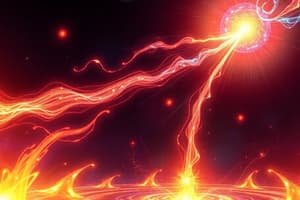Podcast
Questions and Answers
Which action best exemplifies energy conservation?
Which action best exemplifies energy conservation?
- Increasing the use of energy-efficient appliances
- Turning off lights when leaving a room (correct)
- Running the air conditioner with windows open
- Leaving all lights on during the day
What is a major concern associated with nuclear energy?
What is a major concern associated with nuclear energy?
- Minimal impact on the environment
- Low energy production
- Safety issues and risks (correct)
- High cost of implementation
Which energy source is considered replenishable and sustainable?
Which energy source is considered replenishable and sustainable?
- Oil
- Coal
- Solar (correct)
- Natural Gas
What is the primary method of energy production in nuclear reactions?
What is the primary method of energy production in nuclear reactions?
How does distance differ from displacement in physics?
How does distance differ from displacement in physics?
What is the relationship between speed and velocity?
What is the relationship between speed and velocity?
What happens to an object's kinetic energy when it experiences a force?
What happens to an object's kinetic energy when it experiences a force?
According to the law of conservation of energy, what happens to energy in a closed system?
According to the law of conservation of energy, what happens to energy in a closed system?
Which of the following best describes speed?
Which of the following best describes speed?
What does distance measure in relation to an object's motion?
What does distance measure in relation to an object's motion?
How are velocity and speed different from each other?
How are velocity and speed different from each other?
What is a key reason why governments and businesses are increasingly investing in renewable energy technologies?
What is a key reason why governments and businesses are increasingly investing in renewable energy technologies?
Flashcards are hidden until you start studying
Study Notes
Energy: Conservation, Nuclear, Renewable, and Motion
Energy is a fundamental concept in our lives and the natural world, driving everything from the smallest chemical reactions to the largest industrial systems. In this exploration of energy, we'll delve into its conservation, various sources, and the relationship between energy and motion.
Energy Conservation
Energy conservation involves using resources efficiently to minimize waste and reduce the negative impacts of energy use on the environment. This can manifest in simple actions like turning off lights when leaving a room or investing in energy-efficient appliances. Conservation also encompasses broader, systemic changes, such as transitioning to renewable energy sources and improving building design to maximize energy efficiency.
Nuclear Energy
Nuclear energy derives from the release of energy during nuclear reactions, primarily through the fission of heavy atoms or fusion of light atoms. This method produces vast amounts of energy and has become a significant source of electricity globally. However, nuclear energy also raises concerns about waste management, safety, and proliferation of nuclear weapons.
Renewable Energy
Renewable energy sources are replenishable and abundant, providing clean, sustainable alternatives to traditional fossil fuels. These sources include solar, wind, hydroelectric, and geothermal power. Renewable energy is gaining prominence due to its potential to reduce greenhouse gas emissions and mitigate the impacts of climate change. Governments and businesses worldwide are increasingly investing in renewable energy technologies to meet energy demands and promote a low-carbon future.
Energy and Motion
Energy and motion are closely intertwined in the realm of physics. When an object in motion experiences a force, its kinetic energy increases, and its speed may change. Conversely, when an object is in a state of rest, it possesses no kinetic energy. The relationship between energy and motion is further explicated by the law of conservation of energy, which states that energy cannot be created or destroyed, but it can be transformed from one form to another.
Distance, Velocity, and Speed
Distance, velocity, and speed are essential concepts in understanding motion and the relationship between energy and motion. Distance is a measure of how far an object travels, while velocity describes the object's speed and direction of motion. Speed, on the other hand, is simply the rate at which an object moves, expressed as distance per unit time. These concepts are fundamental in determining the energy required or released when an object moves, accelerates, or becomes stationary.
Future Outlook
Continued research and innovation in energy conservation, nuclear, and renewable energy sources will enable us to develop a more sustainable, efficient, and eco-friendly energy ecosystem. Policymakers and technologists must work together to address current challenges and opportunities to develop a just, equitable, and low-carbon energy future.
Studying That Suits You
Use AI to generate personalized quizzes and flashcards to suit your learning preferences.




